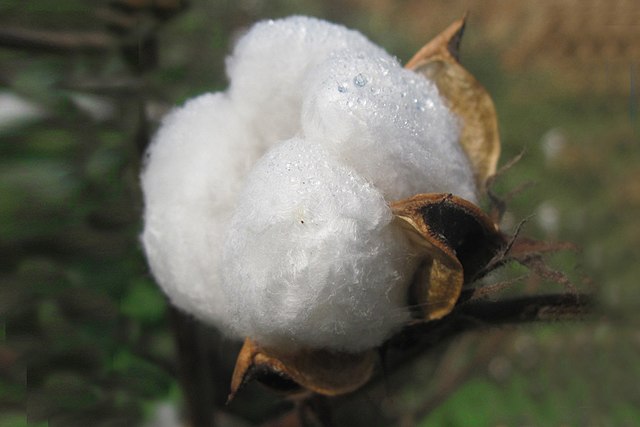
What is cotton? Cotton is a fiber that grows around the seeds of the cotton plant.
About 27 million tons of cotton is produced every year. India is the largest producer, with 6.1 million tons, and it is followed by China, the USA, Brazil, and Pakistan, in that order. A standard t-shirt requires approximately 226 g of cotton, so it’s possible to make about 120 billion t-shirts every year.
But what exactly is cotton? It is made up of fibers that grow inside the cotton plant to protect the seed. Cotton plants need a long frost-free period, lots of sunshine and a moderate amount of rainfall to grow. The seeds are usually planted in March or April and they usually sprout after about 10 days. The plant will develop leaves and will produce flowering buds after about 6 weeks. These buds are called “squares”. The plant will produce a flower after about 9 weeks and the flower will die and fall off the plant after a few days. When the flower falls off, it will leave the boll, which is where the cotton will be produced.
The average boll will have about 32 cotton seeds. The cotton seeds need to be fertilized for the boll to produce large amounts of cotton. Unfertilized seeds will produce cotton, but not as much. Once the seed has been fertilized, it starts to expand. Some of the cells on the surface of the seed change to become fiber cells. These cells stop dividing and start growing outwards. They are made of a carbohydrate called cellulose, which is a polymer made of glucose. Enzymes connect the glucose molecules together to make cellulose, which is what the cell walls in plants are made of. Each fiber in the cotton is one very long cell.
The fibers coming off the seeds grow very quickly for the first 18 days. To allow them to do this they produce an enzyme called peroxidase which softens the cell wall and lets them expand so rapidly. When they have finished growing, they produce the enzyme cellulose synthase, which produces cellulose and hardens the walls again. Shortly after this process has finished, the fibers die and this is when they become the cotton that we know. The fibers start to bend and twist together, making it easier to spin them into yarn. One cotton boll can produce about 500,000 cotton fibers. As the boll ripens, the expanding cotton splits it open and sticks out. If the cotton isn’t picked, the cotton ball will eventually be blown out of the open boll and will fly away on the wind. When it lands, it can use the ball of cotton as protection and as a source of nutrients before it begins to germinate.
How do the cotton fibers in the boll become a t-shirt? When the cotton is ripe it is picked from the plants. This used to be done by hand and was a very hard job. Slaves were notoriously used on cotton plantations. An adult could probably pick about 50 kg of cotton in a day. These days, in developed countries, the cotton is picked by a machine which can harvest about 10 acres of cotton an hour. The difference is staggering. However, most cotton from developing countries and China is still picked almost entirely by hand. Quite often women and children are used to pick it. In China, forced labor is also used. Once the cotton has been harvested, it is combined into a bale of about 250 kg, which is taken to a textile mill. The cotton is cleaned by machine, the fibers are straightened into untwisted ropes called “slivers” and they are fed into a spinning machine. The spinning machine twists the fibers into yarn or thread. This thread can then be threaded into a loom to make material.
Humans have been picking cotton for over 7,000 years. The Indus Valley Civilization (roughly where Pakistan is now) and Mesoamerica (where Mexico and Central America are now) were cultivating cotton as far back as 5000 BC. Cotton cultivation spread to Arabia and the Middle East, but it didn’t reach Europe until the Middle Ages. In fact, the word “cotton” comes from the Arabic word “quton”. The Industrial Revolution made it possible to rapidly and cheaply produce huge amounts of cotton. Cotton became Britain’s leading export for over a hundred years.
Cotton is such an important global crop that it can have a huge impact on the economy. It is also a crop that comes with many problems. Not only is it often harvested by women and children, the farmers quite often don’t receive a far price for their cotton. On top of that, 1 kg of cotton needs about 12,000 liters of water, which is causing huge environmental damage. The Aral Sea has all but disappeared because of cotton production. There are other plants that could replace cotton, such as hemp and even banana fibers, but cotton still plays too big a place in the global economy for this to happen. I’m sure, though, at some point it will. And this is what I learned today.
Sources
https://learn.genetics.utah.edu/content/cotton/what
https://www.frontiersin.org/articles/10.3389/fpls.2012.00104/full
https://www.cottonmill.com/blog/the-life-cycle-of-the-cotton-plant/
https://www.theworldcounts.com/challenges/consumption/clothing/world-cotton-production-statistics
https://www.cotton.org/pubs/cottoncounts/story/how.cfm
https://en.wikipedia.org/wiki/Cotton
https://www.masterclass.com/articles/what-is-cotton
https://sewport.com/fabrics-directory/cotton-fabric
https://www.the-sustainable-fashion-collective.com/2014/12/12/how-is-cotton-made-why-bad
https://blog.machinefinder.com/19637/picking-cotton-less-time-john-deere-cp690
